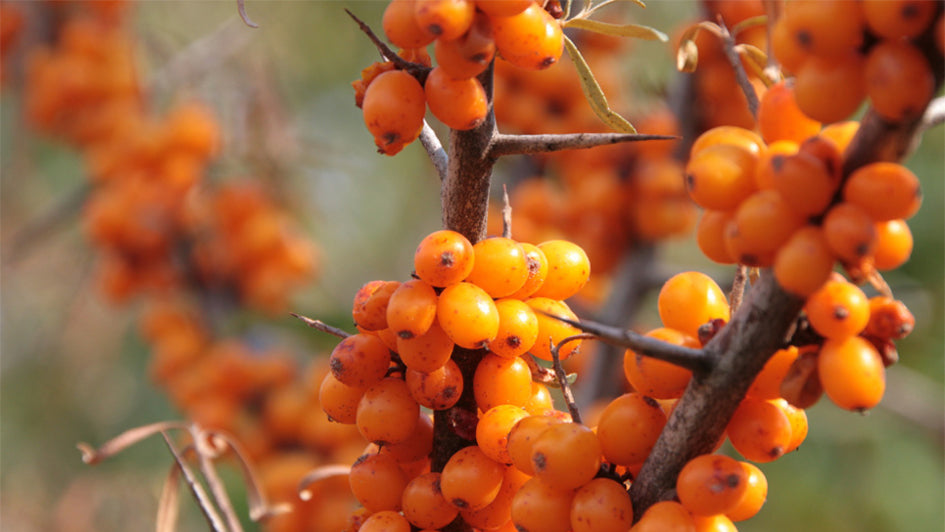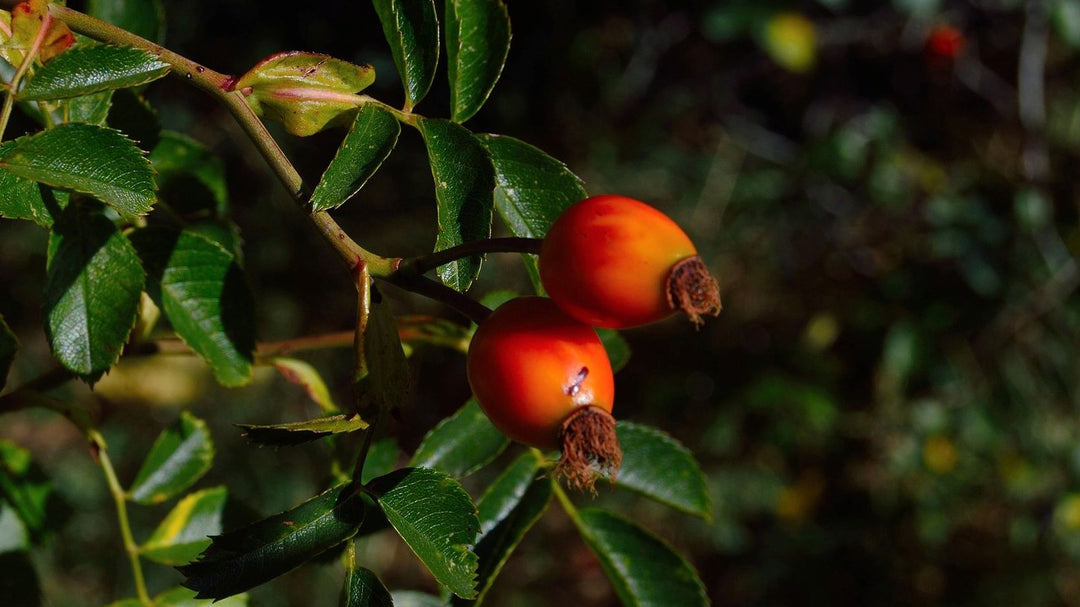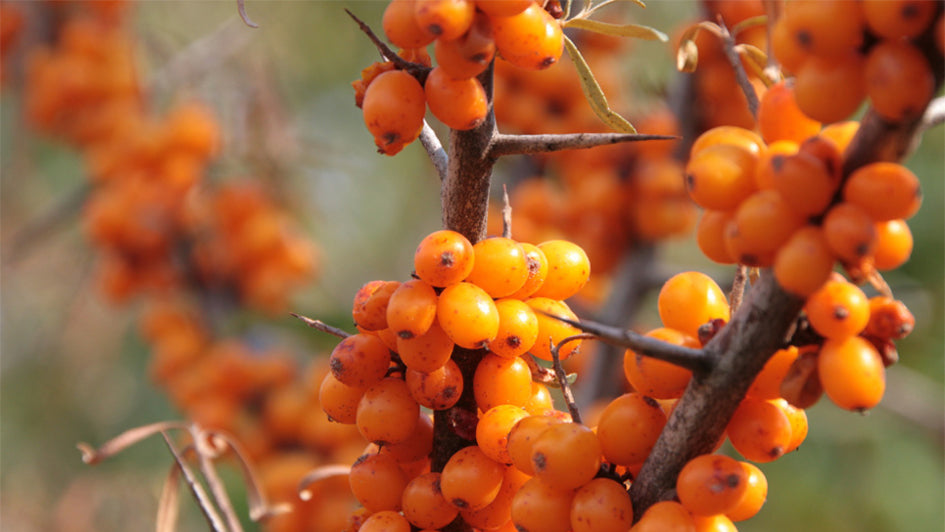The sea buckthorn (hippophae rhamnoides), also known as seaberry, is one of two superfoods we use in our products. This plant is distinguished by the small, bright and numerous orange-colored berries and needle-like thorns along the tree branches.
Tibetan roots
Originating in the Himalayas, sea buckthorn came to flourish in the Tibetan Plateau’s climate, located at a high altitude of 3,000 meters above sea level, in a place untouched by pollution and with the most minimal of human influence. The conditions of its habitat give rise to a uniquely nutrient-rich chemical composition that has made sea buckthorn a valuable medicine since the 8th century, used in ancient Asian traditions to heal both internal and external ails. They were used to improve digestion, soothe stomach troubles, improve the cardiovascular system, boost liver function, treat skin diseases and more.
Sustainable farming
We source our fruit from a farm based in Tibet that practices sustainable harvesting and social responsibility. The plants are wild-harvested by hand picking, never excessively so, with special care taken to maintain the ecological balance. Additionally, the farm has a poverty relief fund in place that guarantees employment for Tibetan farmers and education for their children. Our faith in the supplier translates directly into our brand, which means that we’re always confident in the integrity of our values and what we can bring to you.
Science-backed benefits
Sea buckthorn is also known as a ‘multivitamin’, containing rare bioactive compounds with powerful antioxidant capabilities including:
Ascorbic acid (Vitamin C)
Sea buckthorn contains up to 10 times the amount of Vitamin C compared to oranges. In skincare, Vitamin C’s most renowned property is its ability to stimulate collagen production, which repairs wrinkles and lines while firming skin.
Alpha-tocopherol (Vitamin E)
Vitamin E is anti-inflammatory and photoprotective, enhancing our body’s own defense system against harmful UV rays, staving off unwanted signs of aging including dark spots, dull and gray looking skin and fine lines.
Alpha-linolenic acid (Omega-3)
Omega-3 fatty acids are a well-known essential nutrient for our body. This component is able to accelerate cellular turnover and reduce hyperpigmentation.
Gamma-linoleic acid (Omega-6)
Omega-6 is another essential nutrient. There are several kinds of omega-6 acid, but gamma-linoleic is a rare variety found in high concentration in sea buckthorn. As a component of skin cells, gamma-linoleic acid is able to penetrate easily into the deep epidermal layers and counteract inflammation.
Palmitoleic acid (Omega-7)
Omega-7 fatty acid is not nearly as well-known as its cousins, and that’s because it is found in only a few plant sources, sea buckthorn being one of them. Omega-7’s benefits include the ability to stimulate both collagen and elastin productions, strengthening the skin’s natural protective barrier function.
Oleic acid (Omega-9)
Omega-9 acid is able to enhance skin permeability, allowing bioactive ingredients greater penetration into skin. Its ability to modulate immune responses like inflammation means they play a significant role in wound healing. While all amazing and powerful on their own, these compounds work even better together, elevating each other’s numerous benefits, and providing greater all-round nourishment and protection for our skins.
Have we gotten you interested in adding sea buckthorn into your skincare regime? Try it for yourself in our products!
Sources:
- Cardoso, C., Jr., S. F., Oliveira, L., Vancim, J., Barban, G., Ferraz, D., & Silva, J. (2011). Oleic acid modulation of the immune response in wound healing: A new approach for skin repair. Immunobiology,216(3), 409-415. doi:10.1016/j.imbio.2010.06.007
- Lin, T., Zhong, L., & Santiago, J. (2017). Anti-Inflammatory and Skin Barrier Repair Effects of Topical Application of Some Plant Oils. International Journal of Molecular Sciences,19(1), 70. doi:10.3390/ijms19010070
- Michels, A. J. (2019, January 02). Vitamin C and Skin Health. Retrieved June 14, 2019, from https://lpi.oregonstate.edu/mic/health-disease/skin-health/vitamin-C
- Naik, A., Pechtold, L. A., Potts, R. O., & Guy, R. H. (1995). Mechanism of oleic acid-induced skin penetration enhancement in vivo in humans. Journal of Controlled Release,37(3), 299-306. doi:10.1016/0168-3659(95)00088-7
- Seaberry. (n.d.). Retrieved June 14, 2019, from https://www.puredia.com/seaberry/
- Song, I., Gu, H., Han, H., Lee, N., Cha, J., Son, Y., & Kwon, J. (2018). Effects of 7-MEGATM 500 on Oxidative Stress, Inflammation, and Skin Regeneration in H2O2-Treated Skin Cells. Toxicological Research,34(2), 103-110. doi:10.5487/tr.2018.34.2.103
- Suryakumar, G., & Gupta, A. (2011). Medicinal and therapeutic potential of Sea buckthorn (Hippophae rhamnoides L.). Journal of Ethnopharmacology,138(2), 268-278. doi:10.1016/j.jep.2011.09.024
- Zielińska, A., & Nowak, I. (2017). Abundance of active ingredients in sea-buckthorn oil. Lipids in Health and Disease,16(1). doi:10.1186/s12944-017-0469-7





